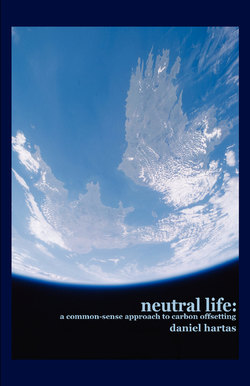Читать книгу Neutral Life: - John Hartas - Страница 4
На сайте Литреса книга снята с продажи.
ОглавлениеGreenhouse Gases
Water Vapour
By far the most common greenhouse gas is water vapour: water in the atmosphere contributes 66% to 85% of the overall greenhouse effect [Ref. 3]. The amount of water vapour in the atmosphere (humidity) varies by location, and is almost entirely part of the natural water cycle. While human activities such as burning fossil fuels do emit water vapour, they do not significantly alter its concentration in the atmosphere.
Gases Emitted by Human Activity
Figure 2. Greenhouse Gases Emitted by Human Activity [Ref. 2].
The Kyoto protocol identifies the six major gases emitted by human activity that contribute to global warming: carbon dioxide, methane, nitrous oxide, hydrofluo-rocarbons (HFCs), perfluorocarbons (PFCs) and sulphur hexafluoride [Ref. 4]. Fig. 2 shows the relative concentration of these gases, and Fig. 3 breaks down the sources of the most significant of these gases by sector.
Figure 3. Human Sources of Greenhouse Gases [Ref. 5].
Global Warming Potential
Table 1. Global Warming Potential of Greenhouse Gases.
These gases do not contribute equally to the greenhouse effect: a tonne of carbon dioxide creates a much weaker greenhouse effect than a tonne of methane. These different strengths of gases are called their ‘global warming potential’ (GWP). Carbon dioxide is by far the weakest of the six Kyoto gases, and is considered the most significant simply because we produce so much of it: by weight alone, carbon dioxide accounts for 99% of human greenhouse gas emissions. Figs. 2 and 3 break down the gases by their mass multiplied by their GWP, to demonstrate their actual contribution to man-made climate change. Table 1 [Ref. 6] shows the GWP of the six Kyoto gases. GWP is defined in terms of carbon dioxide: a GWP of 12 would mean a gas was twelve times more potent a greenhouse gas than carbon dioxide.
This leads to the basic unit of measurement for greenhouse gas emissions: carbon dioxide equivalent, or CO2e. In calculating your carbon footprint, you would give one tonne of methane emitted as 25 tonnes CO2e, because of methane’s strength as a greenhouse gas. Because HFC and PFC are general terms for a range of gases they have a range of GWP values. Their GWP is generally large but they are emitted in relatively small quantities. In terms of individual scale emissions, they are generally not significant: fridges and air conditioners are likely to be the only appliances producing them. Even then, they generally represent only 10% of that appliance’s impact, with the other 90% coming from the electricity used [Ref. 7]. As such, most small-scale carbon footprint calculations don’t take them into account.
